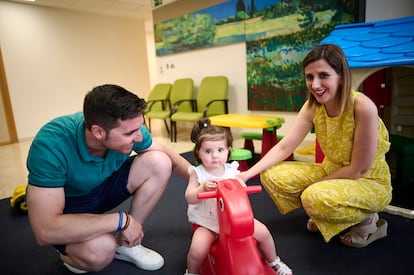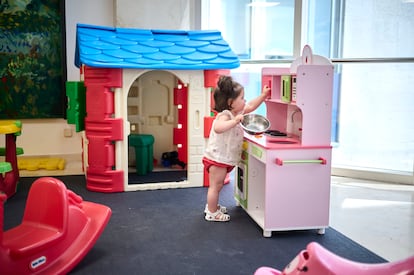How gene therapy is being used to treat deafness
In Spain, the United Kingdom and the United States, researchers are carrying out a trial to try to reverse hearing loss in children born with rare genetic mutations


A few months after the birth of their second daughter, Abril, Daniel and María Montaña decided to try increasingly noisy experiments. First they closed doors shut, then they really slammed them. They played loud music and burst balloons without warning. But their daughter didn’t even flinch, to the surprise of her older sister, Maria, who was startled every time. Some time later, in November 2023, the doctors confirmed that Abril could barely hear, and that she would lose more of her hearing. The culprit, they were told, was a rare genetic mutation that affects a gene that is needed for sound to reach the brain.
Abril is 15 months old. She has her hair tied up in a ponytail, her gaze is very fixed, and she walks from one place to another decisively. You have to look closely to realize that she does not respond to voice, only to eye contact. At six months, she was able to say “dad” and “mom,” but soon after she suddenly stopped talking. Her parents were surprised because they have no family history of the condition. But the doctors told them that each of them has a mutated copy of the gene, and their daughter inherited one from each of them, which is why she has developed the disease. There was a 25% chance of her getting it.
In these cases, the first two years of life are key. This is the time to take action so that the child does not have a speech delay. After that time, the region of the brain used for listening — not receiving any stimulation — usually turns to another task, often vision. Until now, the way to treat the condition was with a cochlear implant, a device that is placed in the inner ear which alleviates hearing loss, but does not cure it.
When they were given the diagnosis, Abril’s father, Daniel Hernández, a 39-year-old salesman from the Spanish region of Extremadura, started looking for answers online. He discovered the results of a clinical trial in China in which several children who were born deaf had started hearing again, and even speaking, after receiving a new gene therapy treatment. When he learned that a similar trial was going to begin in Spain, neither he nor his wife had any doubts.
“We knew we had to do it, even if we were afraid, it was a unique opportunity,” recalled María Montaña, a 37-year-old technical architect, a few days ago in the otorhinolaryngology ward of the Clínica Universidad de Navarra (CUN) hospital, in Pamplona, while waiting for her daughter to come out of hearing tests.

The human ear is a wonder to which we often do not properly recognize. Sound waves reach the ear, are amplified by several tiny bones, and penetrate to the inner ear, where there are a few milliliters of watery fluid called endolymph. Inside the cochlea — a spiral structure similar to the shell of a snail —, there are thousands of hair cells that bathe in this liquid, collect sound waves with their villi and transform them into chemical signals that are transmitted to the first neurons. That’s when the brain hears; all in fractions of a second.
Raquel Manrique, an otolaryngologist at CUN, describes this process as a row of dominoes that fall one by one. In the Abril’s case, there is a gap between two pieces, meaning sound never reaches the brain. This gap is due to a mutation in the OTOF gene that prevents it from producing otoferlin, a protein needed for the cells of the inner ear to communicate with the brain.
On May 2, CUN doctors sedated Abril to make a small incision behind her right ear. The objective was to reach the cochlea — a part smaller than a little fingernail —, introduce a catheter and inject the new gene therapy DB-OTO, developed by the U.S. company Regeneron. The treatment contains the correct version of the gene packaged in harmless adenovirus. These viruses enter the hair cells of the ear and release their genetic cargo, potentially restoring the ability to hear. Recovery is so rapid that the patient leaves the hospital the day after.
Abril is the first girl in Spain to be treated within a clinical trial that is also being carried out in the United Kingdom and the United States. The trial is aimed at evaluating the safety and effectiveness of the experimental therapy. In the United Kingdom, Opal, an 18-month-old deaf girl, has almost completely recovered her hearing. In the United States, in another similar trial, Aissam, a 12-year-old boy, has managed to recover his hearing, although he will probably not be able to learn to speak, his doctors explained to EL PAÍS. China is leading the way with a very similar therapy that produced extraordinary results in six children late last year.
Doctors have not yet detected signs of hearing in Abril. It is not alarming because the first signs can appear up to six months after the treatment. “It’s one thing for us to be placing the missing domino, but now it has to start working, and that takes time. But we are hopeful because the Chinese group has published the results, and they have seen good responses,” says Manrique.
His father, Manuel, is head of otorhinolaryngology at CUN. “We are facing the first curative treatment for these types of deafness. Until now, all procedures were palliative,” he says. The 66-year-old doctor, pioneer of cochlear implants in Spain, believes that this is the first step towards a near future in which this condition and other congenital deafness can be reversed with gene therapy, without the need for other treatments.

“With this type of therapy, the earlier the intervention, the better the recovery of hearing and, therefore, the better the development of the auditory cerebral cortex. If this has not developed, no matter how much they recover their hearing, they can no longer develop language,” he says.
Jonathon Whitton, CEO of Regeneron, explains that for now all patients will receive the treatment in one ear. If the initial success is confirmed, and once the correct dose is adjusted, the second ear will be treated, provided that a cochlear implant has not been placed. “Our intention is to submit an application for approval at the end of next year,” says Whitton, who has been involved in the project since 2016. Regeneron is also investigating similar therapies against more common genetic deafness, such as the lack of the protein connexin.
Daniel, April’s father, knows that if all goes well, his daughter will not remember any of this. These days, he and his wife are so aware of any changes that sometimes it seems as if their daughter has heard them when they call her. But the doctors have told them that they are not going to notice anything. The doctors will be the first to pick up any changes, with the tests that measure the electrical impulses that reach the brain. “The day after she gets her hearing back, we will tell her what has happened since her birth so that she knows. For now, we are within the expected time, and we have to be patient,” says Daniel.
Sign up for our weekly newsletter to get more English-language news coverage from EL PAÍS USA Edition
Tu suscripción se está usando en otro dispositivo
¿Quieres añadir otro usuario a tu suscripción?
Si continúas leyendo en este dispositivo, no se podrá leer en el otro.
FlechaTu suscripción se está usando en otro dispositivo y solo puedes acceder a EL PAÍS desde un dispositivo a la vez.
Si quieres compartir tu cuenta, cambia tu suscripción a la modalidad Premium, así podrás añadir otro usuario. Cada uno accederá con su propia cuenta de email, lo que os permitirá personalizar vuestra experiencia en EL PAÍS.
¿Tienes una suscripción de empresa? Accede aquí para contratar más cuentas.
En el caso de no saber quién está usando tu cuenta, te recomendamos cambiar tu contraseña aquí.
Si decides continuar compartiendo tu cuenta, este mensaje se mostrará en tu dispositivo y en el de la otra persona que está usando tu cuenta de forma indefinida, afectando a tu experiencia de lectura. Puedes consultar aquí los términos y condiciones de la suscripción digital.
More information
Archived In
Últimas noticias
Most viewed
- Sinaloa Cartel war is taking its toll on Los Chapitos
- Oona Chaplin: ‘I told James Cameron that I was living in a treehouse and starting a permaculture project with a friend’
- Reinhard Genzel, Nobel laureate in physics: ‘One-minute videos will never give you the truth’
- Why the price of coffee has skyrocketed: from Brazilian plantations to specialty coffee houses
- Silver prices are going crazy: This is what’s fueling the rally










































